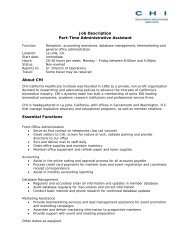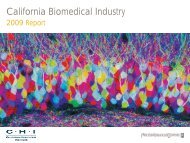Stem cell research facilitiesThe <strong>California</strong> <strong>Institute</strong> forRegenerative Medicine (CIRM)accelerates stem cell research in thestate through grants, loans and matchingfunds. Through its major facilities fundinginitiative, CIRM has awarded $271 millionto 12 institutions: UC Santa Barbara,Stanford, USC, UCSF, UC Santa Cruz,UC Merced, UCLA, UCI, UCB, SanfordConsortium for Regenerative Medicine,and the Buck <strong>Institute</strong> for Age Research.Each recipient was required to raisemore funds through private donations.Altogether, CIRM’s investment broughtin an additional $800 million in financialcommitments and created constructionjobs throughout the state at a time whenthose jobs were very much needed.With CIRM funds allocated in 2008, fiveof the premier new stem cell researchcenters opened in 2010, and constructionis well underway on a sixth:UC Davis <strong>Institute</strong> for RegenerativeCurres. The first of the major CIRMsupportedstem cell research laboratoriesto open, the UC Davis facility is locatedon the university’s Sacramento campus.The 54,000 square feet of renovatedspace includes Northern <strong>California</strong>’slargest academic Good ManufacturingPractice (GMP) laboratory, a stateof-the-artsuite of rooms that willenable scientists to safely prepare andmanufacture cellular and gene therapiesfor clinical trials. Designed to maximizeresearch collaboration and innovation,the facility is a centralized space forresearchers from departments andprograms throughout UC Davis as wellas a shared-research facility for otherinstitutions to use. The initial phase of theproject provides space for approximately20 senior scientists and 115 otherresearchers and technicians; plannedbuild-outs will expand the facility to servemore than 200 personnel. The $62 millionfacility opened on March 10, 2010.Sue & Bill Gross Hall: A CIRM <strong>Institute</strong>.The first major stem cell center inSouthern <strong>California</strong>, and the state’sfirst such facility built from the groundup, UCI’s stem cell research centeropened on May 14, 2010. The four-story,100,000-square-foot building serves asa regional hub for stem cell researchand education. It houses the Sue & BillGross Stem Cell Research Center, dozensof lab-based and clinical researchers,a stem cell techniques course, and amaster’s program in biotechnology withan emphasis on stem cell research.Funding for the $80 million centerincluded $10 million from Sue and BillGross as well as funds from other privatedonors and the University of <strong>California</strong>.UCLA Broad Stem Cell ResearchCenter-<strong>California</strong> <strong>Institute</strong> forRegenerative Medicine Laboratory.Located on the third floor of the newTerasaki Life Sciences Building, theBSCRC provides crucial facilities forstem cell scientists and cutting-edgecore resources in about 21,000 squarefeet. Research conducted in the newspace will range from basic stem cellinvestigations to preclinical translationalscience and, finally, clinical research.Partially funded by a $20 million donationby The Eli and Edythe Broad Foundation,the new research space opened on Oct.25, 2010.Lorry I. Lokey Stem Cell ResearchBuilding. Stanford cut the ribbon onthe largest of the CIRM buildings — agleaming 200,000-square-foot, stateof-the-artfacility — on Oct. 27, 2010.The building, which serves about 550researchers, is the largest dedicated stemcell research building in the country, if notthe world. In addition to CIRM funding,the building was developed with a $75million gift from Lorry I. Lokey.Eli and Edythe Broad CIRM Centerfor Regenerative Medicine and StemCell Research at USC. The five-story,87,500-square-foot, green-certifiedbuilding is designed to house 18 principalinvestigators and their research teams.The new stem cell research center willbe a cornerstone in the biomedicalresearch corridor on the USC HealthSciences campus. Conceived in 2005,the building’s development was fundedthrough the $30 million gift from theBroad Foundation in 2006, a $27 milliongrant awarded by CIRM in 2008 andprivate donations. The building wasdedicated on Oct. 29, 2010.Sanford Consortium for RegenerativeMedicine. Among the CIRM-funded stemcell research facilities under construction,this world-class facility will enablefour of the world’s leading biomedicalresearch institutions — Salk, Scripps,UCSD and Sanford-Burnham — topursue collaborative research projects inregenerative medicine. Scheduled to becompleted in September 2011, the facilityis being developed with $43 million fromCIRM and a $30 million donation from T.Denny Sanford.92 | <strong>California</strong> <strong>Biomedical</strong> <strong>Industry</strong> 2011 Report
Executive profileDr. Ed Holmes, President andCEO of the Sanford Consortiumfor Regenerative MedicineQ: Tell me about the origins ofthe Sanford Consortium.We came into being after the bond issue(Prop. 71) was passed and CIRM wasformed….I think the four institutions(UCSD, Salk, Scripps and Burnham)and the scientists within them allworking together is really what got usstarted. And that is continued to be thefoundation of what we do.Q: We are at a dynamic time forstem cell research — especiallywith the first human trial onspinal cord injury. What excitesyou most about the researchabout to happen here?We have begun to engage a wide groupof scientists from all four institutionsand you can see the genuine excitement.We have also begun to identify threetheme areas to work in. Neurosciences,because that is an important areafor stem cell research. Also, in thearea of cancer biology we have got atremendous amount of strength, and incardiovascular disease.But what we have discovered is thereiss so much more and we do not wantto exclude people, so we will probablyconcentrate on these three areas butembrace, though special projects, otherthings that would be important to bringinto this.We are in the position to choose amongthe very best people, but, at the sametime, we envision the consortium tobe more than this building. It is thescience but it is also all four institutions.Just because you are not located in thebuilding does not mean that you arenot a part of the Sanford Consortium.So, they have come up with some cleverways to engage people who might not bein the building long-term with specialprojects.Q: A lot of this depends on theleveraging of federal funds andright now this is still up in the air,with stem cell research held up inthe courts. What concerns do youhave there?Nobody can predict what is going tohappen in Washington and obviouslyit is an up and down situation. But Iwould say the disquiet in Washingtonhas been a boon for <strong>California</strong>. Youfind people who want to come anyway,but they want to come even more now.It would be really nice if the federalgovernment gets it sorted out — andI, personally, think they will. I amoptimistic the federal government willstraighten itself out and begin to makeinvestments.Q: What are the designconsiderations for enablingcollaborative work?For collaboration to work, first you needopportunity. We have rooms intendedto reduce certain types of behaviorand encourage collaboration. We haveteam rooms so six people at a time canhook up computers. It is a smartboard,so they can write on the screen so itcaptures the image plus what theyannotate on their screen.The building calls for wide openstaircases and large open spaces thatconnect. It should allow people to morevertically circulate.Q: Did you model this buildingafter any other facilities in thecountry?The exterior was designed toacknowledge that it has to fitcontextually with the iconic structurethat is the Salk. It started with thescientists back in 2007. This is a LEEDgold building. We are using chilledbeams throughout. We are also takingadvantage of the fact that we live ina great part of the world. We face theocean here on top of the Torrey PinesMesa, which allows for some fantasticviews. We plan to build an open-airreception space and fully take advantageof the Southern <strong>California</strong> climate.<strong>California</strong> <strong>Biomedical</strong> <strong>Industry</strong> 2011 Report | 93






